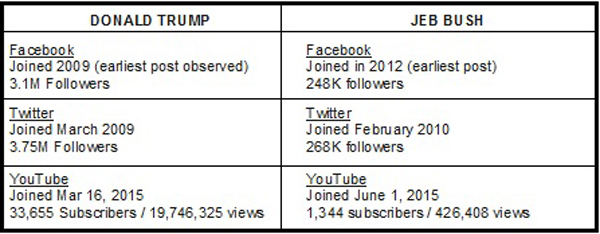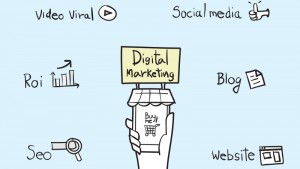Brands should take a page from Donald Trump and other candidates who are using social media to capture the attention of their audience, says columnist Jason Warnock.
Donald Trump has surged to the top of the polls in the GOP primary race, taking a double-digit lead over seasoned and tenured political operators.
Everyone is talking about Trump, but what’s really happening here? Why is Trump capturing all the headlines and seemingly sucking the oxygen out of the room?
To a large extent, it’s because he has the loudest voice in the room — or more accurately, the loudest voice in the “digital room.”
For better or worse, Trump is cashing in on the massive social presence he has cultivated over the years and wielding his multi-channel assets like a CMO instead of a traditional politician.
Breaking Down Trump’s Social Presence
There are a lot of reasons (political and non-political) why Trump is outperforming the other candidates in the GOP field. And his ability to connect with voters through social media is clearly one of the driving forces behind his early success.
Unlike the other GOP candidates, Trump gives more value to social media as a primary communication channel. In fact, the data shows that when it comes to the “big 3” social media channels (Facebook, Twitter and YouTube), Trump commands an even bigger lead over his nearest rival, Jeb Bush, than he does in the polls.

Trump’s social following is nearly 10 times larger than many of the other GOP front-runners. Compared with the rest of the field, Trump has the largest megaphone in the race, and he’s not afraid to use it to drown out the messages of his rivals.
What Marketers Can Learn From Trump
Trump’s large social following gives him a serious advantage over the other candidates. But it’s not just the size of his social presence that gives him an advantage — it’s also the way that he uses his social presence to connect with key audiences.
Regardless of your politics, as a marketer there are several lessons you can learn from Trump’s use of social media, and you can apply those lessons to your social marketing strategies:
1. Study The Competition
The viral capacity of Trump’s social media presence caught the other candidates napping, causing several of them to quickly roll out social campaigns in an effort to duplicate The Donald’s success.
For example, on July 21, Rand Paul tried to go viral with a YouTube video in which he destroyed a copy of the current tax code using fire, a wood chipper and a chainsaw. The video fell flat.
Instead of studying Trump’s tactics, Paul unsuccessfully attempted to achieve the same results with a social stunt.
Like politicians, brands need to study their competitors’ campaigns, as well as track which elements of the campaign were actually successful — whether on social media or through email marketing.
In addition to uncovering what, when and where the competition is launching, marketers need to learn how well competitors’ campaigns are doing and who is engaging with them. By better understanding the competition’s strategy and audiences’ behavior, marketers can improve their ability to craft effective multi-channel campaigns for their own brands.
2. Cultivate A Following
Many of Trump’s rivals severely underestimated the value of his large social following during the earliest stages of the race.
When his campaign launch video and other social content went viral, the other candidates started paying attention. But unfortunately, their social options were limited because none of them had taken the time to cultivate and grow their own social following.
When Trump released Lindsey Graham’s mobile phone number during a rally in South Carolina, the Graham campaign’s first response should have been to counter Trump’s move via social media.
But Graham’s social following was weaker than Trump’s (Facebook: 128k, Twitter: 24k, YouTube: 1k), so the Graham campaign needed to be strategic in its response.
As a result, Graham released a video a day later, called “How to Destroy Your Cell Phone,” that has received more than 2.1 million views to date, proving that other candidates also have the potential to capture the public’s attention through social media.
I think it’s safe to assume that a large chunk of those views were shared through channels beyond social media — email, for example.
Here, the lesson for marketers is twofold. First, the cultivation of a social following directly affects the ability to leverage social media for brand advantage; and like politicians, brands should pay attention to the channels consumers are using and target their messaging accordingly.
For example, using its proprietary Market Intelligence tool, Yesmail (my employer) tracked and analyzed leading retailers’ social campaigns across Facebook, Twitter, YouTube, Instagram and Google+ and found that brands on Instagram experienced an average follower growth rate of 278 percent in 2014.
Marketers that know where their consumers are interacting can implement the right campaign message on the right channel at the right time.
Additionally, Graham proved that relevant, timely content prevails and can have a resounding impact on a campaign, regardless of follower size. When crafting a campaign, whether via social media or email marketing, marketers that follow Graham’s approach can resonate with their audience.
For email marketing, the use of triggered emails — emails that are sent based on consumer behavior like abandoned carts and other events — is one way to ensure relevancy.
When opportunities arise, social can be a powerful venue for connecting with key audiences — but only to the extent that the brand has systematically engaged a large cadre of followers.
3. Embrace The Speed Of Social Media
The Trump campaign routinely uses the speed of social media to outmaneuver critics. After the first GOP debate, Trump almost immediately took to Twitter to spin the controversy surrounding his interactions with Megyn Kelly, effectively using social media to navigate past issues that would have destroyed other candidates.
Not all candidates are as adept as Trump, or at least the Trump camp, in embracing the speed of social media.
For example, on August 4, candidate Jeb Bush told an audience of conservative voters that he wasn’t sure the US needs to spend half a billion dollars a year on women’s health issues. A day later, he tried to backtrack and clarify his comments, but his response was too late, because the damage had already been done.
For brands and marketers, the takeaway is that social media is “right now” technology that can be used to build or deflate momentum around real-time events, and it’s a powerful tool when paired with other marketing channels, like email. By understanding and embracing the speed of social media, brands can connect with audience segments with the right message at the right time.
What’s more, marketers that incorporate social share buttons into their email marketing efforts can maximize engagement and track and reward brand advocates.
Major brands and political campaigns are very similar when it comes to marketing. While campaigns work to win the attention of voters, brands strive to capture the attention of customers.
By watching what Trump and other candidates do well — and not so well — this political season, you can learn important lessons about how to orchestrate the use of social media in a brand context.
Some opinions expressed in this article may be those of a guest author and not necessarily Marketing Land. Staff authors are listed here.









